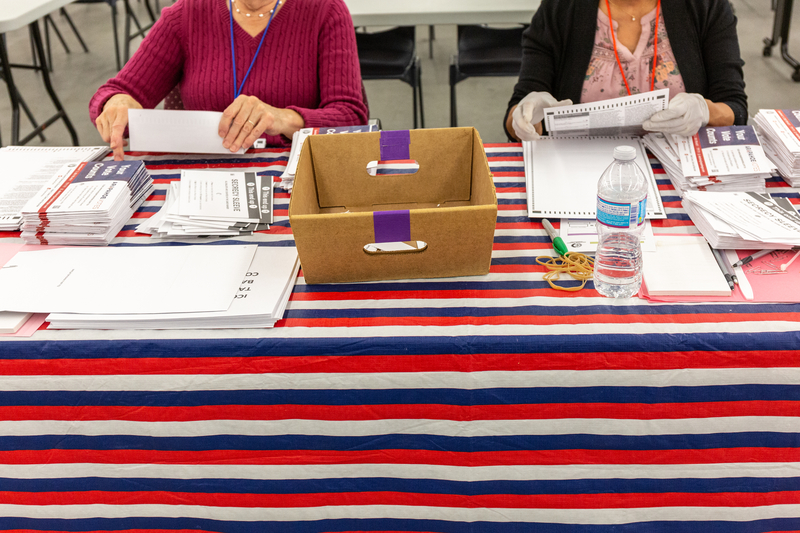
By Morgan Thomas, Policy Associate
When voters take to the polls, they not only vote on political candidates, but also ballot measures. Most voters know where they stand on these measures, but how much thought is given to how they made it onto the ballot in the first place?
To answer this question, one must first define a ballot measure. A ballot measure is a proposed law, issue, constitutional amendment or question that appears on a statewide or local ballot for voters of the jurisdiction to vote on.
In the United States, a ballot measure can make it onto the ballot through one of three means: citizen initiative, legislative referral or automatically in some states. Each state has different requirements to get an issue to appear on the ballot; however, most ballot measures are placed on the ballot through citizen initiatives or legislative referrals.
State-by-State Ballot Measure Initiatives
Citizen-Initiated Ballot Measures
The citizen initiative process allows citizens to propose a constitutional or statutory amendment, or a veto referendum, for inclusion on a ballot. This can be achieved through direct or indirect means, both of which require citizens to collect a specified number of signatures prior to being placed on the ballot.
Citizen-initiated ballot measures were first adopted by South Dakota in 1898. Since then, 26 states and the District of Columbia have adopted the citizen initiative process as a valid means to place an issue before the public for a vote. More specifically:
- Eighteen states allow for citizen-initiated constitutional amendments.
- Twenty-one states allow for citizen-initiated amendments to state statute.
- Two states — Maryland and New Mexico — allow for veto referendums but not initiated state statutes or amendments.
Although a state may not allow citizen initiatives at the state level, they can be used at the city level to place issues on the ballot for consideration locally.
Direct Initiative
A citizen-initiated ballot measure can be placed on a ballot for voters through direct initiatives. Direct initiatives can be placed on the ballot as a state statute, constitutional amendment or veto referendum. Placing a measure on the ballot through direct initiative entails the following steps:
- Preliminary filing — An individual files a proposed ballot measure to appear on the ballot with their designated state official.
- Proposal review — The official with which the proposed measure was filed reviews the language of the measure and its conformance with state statutory requirements.
- Measure title and summary preparation — Once the review of a proposed ballot measure is complete, a ballot title and summary are prepared and then made into a petition to be circulated for signatures.
- Circulation and signature collection — The petition detailing the proposed ballot measure is circulated for signature.
- Petition submission — When the petition obtains the required number of signatures, it is then submitted to the state’s election official, who verifies the signatures.
- Placement on ballot — If all signatures have been verified and approved, the proposed ballot measure is placed on the ballot for voter’s consideration.
At the time of writing, 14 states allow state statute to be amended via direct initiative and 16 states allow the state constitution to be amended via direct initiatives. California and Colorado are the only two states that allow for both constitutional amendments and statutory amendments to be proposed via direct initiative.
Veto Referendum
Through the citizen initiative process, voters can also place a veto referendum on the ballot for consideration. Unlike a statutory or a constitutional amendment, a veto referendum, also known as a popular referendum or people’s veto, is a ballot measure that asks voters whether they want to uphold or repeal an existing law. Like a directly initiated ballot measure, a veto referendum requires a minimum number of verified petition signatures to place the proposed ballot measure on the ballot. At the time of writing, 23 states allow veto referendums.
Indirect Initiative
A citizen-initiated ballot measure can also be placed before voters through an indirect initiative. Indirectly initiated ballot measures follow a slightly different process than directly initiated ballot measures. Indirectly initiated statutory and constitutional amendments require citizens’ signatures and approval from the state legislature. Once the minimum number of signatures is received, the state legislature may approve the statute outright without placing it on the ballot. If the statute does go on the ballot, a majority vote is needed to pass it.
There are nine states that allow indirectly initiated state statutes. Of those nine states, Maine, Massachusetts, Michigan, Nevada and Washington allow the state legislature to propose alternative statutes to appear alongside indirectly initiated state statutes on the ballot. Only Massachusetts and Mississippi allow citizens to initiate constitutional amendments indirectly.
Legislatively Referred Ballot Measures
Another common method of placing a measure on the ballot is through legislative referral. A legislatively referred ballot measure is an issue, question or law that appears on a state or local ballot due to a vote by state legislators.
In addition to citizen-initiated ballot measures, statutory or constitutional amendments can be proposed through legislative referrals. Legislatively referred statutes, also known as legislative referendums or referendum bills, only require voter approval if they amend a statute that was previously enacted through a citizen initiative. Constitutional amendments referred by a state legislature require voter approval in 49 out of 50 states regardless of how the constitutional provision was put in place. Delaware is the only state where voter approval is not required for constitutional amendments.
Automatically Referred Ballot Measures
Ballot measures can also be put before the public for a vote without action from citizens, the legislature or governing body. This process is referred to as automatic ballot referral and is often outlined in state law or in a state’s constitution.
Automatically referred ballot measures appear on the ballot under specific circumstances per the direction of a special commission or for a state constitutional convention. For example, in some states, the constitution requires that a ballot proposition be placed on the general election ballot every 10 to 20 years, depending on the state, to ask if citizens want to hold a constitutional convention.
Below is a table highlighting ballot measure initiatives for all 50 states and the District of Columbia, as well as a link to the ballot measure law and/or procedure for each.
| State | Citizen Initiative Process | Legislative Referral | Veto Referendum |
| Alabama | No | Yes | No |
| Alaska | Yes | Yes | Yes |
| Arizona | Yes | Yes | Yes |
| Arkansas | Yes | Yes | Yes |
| California | Yes | Yes | Yes |
| Colorado | Yes | Yes | Yes |
| Connecticut | No | Yes | No |
| Delaware | No | Yes | No |
| District of Columbia | Yes | Yes | Yes |
| Florida | Yes | Yes | No |
| Georgia | No | Yes | No |
| Hawaii | No | Yes | No |
| Idaho | Yes | Yes | Yes |
| Illinois | Yes | Yes | No |
| Indiana | No | Yes | No |
| Iowa | No | Yes | No |
| Kansas | No | Yes | No |
| Kentucky | No | Yes | No |
| Louisiana | No | Yes | No |
| Maine | Yes | Yes | Yes |
| Maryland | No | Yes | Yes |
| Massachusetts | Yes | Yes | Yes |
| Michigan | Yes | Yes | Yes |
| Minnesota | No | Yes | No |
| Mississippi | Yes | Yes | Yes |
| Missouri | Yes | Yes | Yes |
| Montana | Yes | Yes | Yes |
| Nebraska | Yes | Yes | Yes |
| Nevada | Yes | Yes | Yes |
| New Hampshire | No | Yes | No |
| New Jersey | No | Yes | No |
| New Mexico | No | Yes | Yes |
| New York | No | Yes | No |
| North Carolina | No | Yes | No |
| North Dakota | Yes | Yes | Yes |
| Ohio | Yes | Yes | Yes |
| Oklahoma | Yes | Yes | Yes |
| Oregon | Yes | Yes | Yes |
| Pennsylvania | No | Yes | No |
| Rhode Island | No | Yes | No |
| South Carolina | No | Yes | No |
| South Dakota | Yes | Yes | Yes |
| Tennessee | No | Yes | No |
| Texas | No | Yes | No |
| Utah | Yes | Yes | Yes |
| Vermont | No | Yes | No |
| Virginia | No | Yes | No |
| Washington | Yes | Yes | Yes |
| West Virginia | No | Yes | No |
| Wisconsin | No | Yes | No |
| Wyoming | Yes | Yes | Yes |





